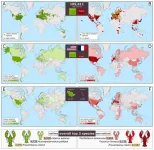Human temporal resolution of odor is shorter than thought: Study
2024-10-14
(Press-News.org)
When we inhale, airborne chemicals enter our nose, creating the "odor" we detect. These chemicals are then expelled when we exhale. Each breath lasts 3–5 seconds, which seems to limit how quickly we can perceive odors. Chemical changes that occur within a single breath appear to be combined into one odor. Because of this, our sense of smell, or olfaction, is often considered a slow sense.
Now, however, researchers led by Dr. ZHOU Wen from the Institute of Psychology of the Chinese Academy of Sciences have challenged this view. Their new study, published in Nature Human Behaviour, shows that human olfactory perception can detect fine chemical changes within the duration of a single sniff.
Dr. ZHOU's team developed a unique sniff-triggered device that controls odor delivery with a precision of 18 milliseconds—about the duration of a frame on a regular LCD display (60 Hz). Using this device, the team created temporal odor mixtures, presenting two odors one after the other with precisely measured delays. They tested 229 participants across five experiments to see if they could distinguish these mixtures.
The researchers found that when two odor compounds, A and B, were presented in different orders (A before B and B before A), participants could tell the difference when the delay between the compounds was just 60 milliseconds—about a third of the time it takes to blink. For comparison, the frequency at which flickering green and red lights appear continuous is around 10–20 Hz (50–100 ms resolution).
Participants’ ability to distinguish the odors improved with longer delays between the compounds and did not depend on knowing the correct order. They could distinguish "A before B" from "B before A" by smell, even if they couldn't identify the order. This ability was not influenced by factors like odor intensity, pleasantness, pungency, or the total amount of odorant molecules in a sniff.
These findings support the existence of a temporal code for odor identity. By providing precise control over odor delivery that aligns with natural sniffing dynamics, this research opens new avenues for studying the temporal aspects of olfactory perception and developing olfactory displays.
"A sniff of odors is not a long exposure shot of the chemical environment that averages out temporal variations. Rather, it incorporates a temporal sensitivity on par with that for color perception," said Dr. ZHOU, the study's corresponding author.
This study was supported by the Ministry of Science and Technology of China, the Chinese Academy of Sciences, the National Natural Science Foundation of China, and the China Postdoctoral Science Foundation.
END
[Attachments] See images for this press release:

ELSE PRESS RELEASES FROM THIS DATE:
2024-10-14
Leuven, 14 October 2024 - The human brain’s remarkably prolonged development is unique among mammals and is thought to contribute to our advanced learning abilities. Disruptions in this process may explain certain neurodevelopmental diseases. Now, a team of researchers led by Prof. Pierre Vanderhaeghen (VIB-KU Leuven), together with scientists of Columbia University and Ecole Normale Supérieure has discovered a link between two genes, present only in human DNA, and a key gene called SYNGAP1, which is mutated in intellectual disability and autism spectrum disorders. Their study, published in Neuron, provides a surprisingly direct link between human brain ...
2024-10-14
The future of wireless technology — from charging devices to boosting communication signals — relies on the antennas that transmit electromagnetic waves becoming increasingly versatile, durable and easy to manufacture. Researchers at Drexel University and the University of British Columbia believe kirigami, the ancient Japanese art of cutting and folding paper to create intricate three-dimensional designs, could provide a model for manufacturing the next generation of antennas.
Recently published in the journal Nature Communications, research from the Drexel-UBC team showed how kirigami — a variation of origami — ...
2024-10-14
Researchers from Peking University have conducted a comprehensive systematic review on the integration of machine learning into statistical methods for disease risk prediction models, shedding light on the potential of such integrated models in clinical diagnosis and screening practices. The study, led by Professor Feng Sun from the Department of Epidemiology and Biostatistics, School of Public Health, Peking University, has been published in Health Data Science.
Disease risk prediction is crucial for early diagnosis and effective clinical decision-making. However, traditional statistical models, such as logistic regression and Cox proportional hazards regression, often ...
2024-10-14
Some people believe that talking to your plants makes them thrive. While there’s limited scientific support for sound improving plant health, there’s a growing amount of evidence about the benefits of mechanical stimulation, like touch, wind or rain. Researchers reporting in ACS’ Journal of Agricultural and Food Chemistry examined the impact of watering practices on tomato plants. They found that the size of the water droplets affected plant growth and resistance to pests and pathogens.
Climate change threatens crop production as rising ...
2024-10-14
Preeclampsia is a life-threatening pregnancy complication marked by persistent high blood pressure that is even more serious when it occurs early in the first trimester. The exact cause of early-onset preeclampsia is unknown, and it is difficult to predict, prevent and diagnose. Now, in ACS’ Journal of Proteome Research, researchers report on six proteins that could be used as targets to diagnose and treat the condition.
Preeclampsia’s key symptom is high maternal blood pressure, and serious cases can lead to maternal organ failure, low infant birth weight, or maternal or fetal death. ...
2024-10-14
Artificial intelligence can help people process and comprehend large amounts of data with precision, but the modern image recognition platforms and computer vision models that are built into AI frequently overlook an important back-end feature called the alpha channel, which controls the transparency of images, according to a new study.
Researchers at The University of Texas at San Antonio (UTSA) developed a proprietary attack called AlphaDog to study how hackers can exploit this oversight. Their findings are described in a paper written by Guenevere Chen, an assistant professor in the UTSA Department of Electrical and Computer Engineering, and her former ...
2024-10-14
Freshwater crayfish, keystone species of aquatic ecosystems, are now at the center of a new tool that promises to revolutionize conservation efforts. World of Crayfish™ (WoC), a newly launched web platform, aims to provide real-time global mapping of freshwater crayfish and their pathogens, offering an invaluable resource for researchers, conservationists, and environmental stakeholders.
Published in PeerJ Life and Environment, the article, World of Crayfish™: A web platform towards real-time global mapping of freshwater crayfish and their pathogens, highlights the urgent need for accurate, up-to-date data on ...
2024-10-14
Biodiversity is in crisis. Human activities are driving species extinctions at unprecedented rates, but funding for conservation remains woefully inadequate. To address this gap, the concept of a Biodiversity Credit Market (BCM) has emerged, inspired by carbon credit systems that incentivize conservation and restoration efforts.
However, while the BCM holds promise, it risks falling into the same pitfalls as its carbon counterpart—especially if it fails to implement rigorous science-backed baselines, ...
2024-10-14
DAEJEON, South Korea (October 14, 2024) – Qunova Computing, a developer of quantum software applications designed to bring quantum computing to the chemical, pharmaceutical and industrial engineering industries, today announces the results from a series of recent tests performed on three different NISQ era quantum computers, each with a different qubit count. In each demonstration, Qunova’s algorithm was able to produce results with accuracy below the threshold of 1.6 millihartrees required for real-world quantum chemistry applications, a level known as ‘chemical ...
2024-10-14
Scientists have successfully bred corals to improve their heat tolerance
A new study has shown that selective breeding can lead to a modest rise in coral heat tolerance.
Led by experts at Newcastle University’s Coralassist Lab, the study documents the world’s first effort to selectively breed adult corals for enhanced heat tolerance, i.e. the ability of adult corals to survive intense marine heatwaves. The breeding effort was a success, showing that it is possible to improve the heat tolerance of adult coral offspring, even in a single generation.
However, the improvement was modest in comparison ...
LAST 30 PRESS RELEASES:
[Press-News.org] Human temporal resolution of odor is shorter than thought: Study







